|
1.
CENTRAL/ WEST AFRICA
Sustained demand stabilizes prices for West African logs
The West African log market was more stable and further price reductions for lesser used species
were not seen during October. China and India have been actively purchasing premium timbers,
which has helped to maintain prices for belli and padouk. European buying has
strengthened prices for moabi, which has moved EUR23 per m3 higher. Sapele prices have also risen by EUR15 per
m3 for LM grade and EUR30 per m3 for B and BC/C grades. Sipo has also gained EUR15 per m3 for
LM, B and BC/C grades.
Although forecasts for European tropical hardwood demand reflect a more pessimistic view of the
carpentry and joinery sector, there is continued demand for premium timbers and prices for logs
and lumber are forecast to remain stable. The outlook for Far East markets is colored
by the reported downturn in Japan (see TTM 12:19) that has especially affected the plywood industry.
Malaysia has felt the effects of the downturn and Indonesia¡¯s efforts to increase plywood exports are
also likely to be subdued for the time being. Meanwhile, China¡¯s plywood exports
continue to increase, which is good news for the West African log industry. The demand for okoume continues
to be very brisk and there is still competition from China, France and Germany for the limited supply
of bubinga.
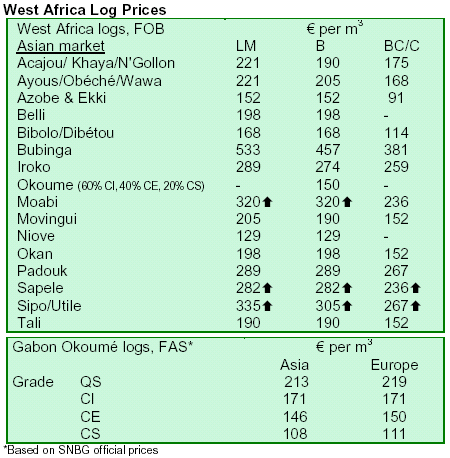
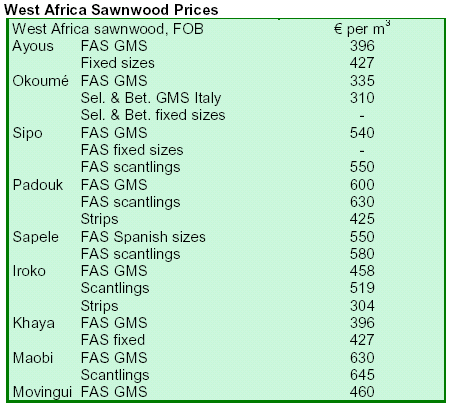
2. GHANA
Government launches project to revitalize MSMEs
An article in The Statesman recently explained the Ghanaian Government¡¯s new five-year project to
revitalize the Micro, Small and Medium Enterprise (MSME) sector. The project, worth US$118.9
million, aims to improve productivity and profitability of the sector. The project,
which is one of ten projects co-sponsored by the International Development Agency/International Finance
Corporation, will support ¡®entrepreneurial development, reduce business constraints faced by MSME, and build
integrated market access and trade facilitation infrastructure¡¯. The outcomes of the project should
enhance the competitiveness of MSMEs and create employment.
Hope for Ghana¡¯s forest linked to VPA
According to BBC News, Ghana¡¯s negotiations on a voluntary partnership agreement (VPA) with the
EU continue, with the hope that the new agreement will reduce illegal logging and deforestation in
the country. Additionally, as the EU is a major trading partner of Ghana, the VPA could reverse the
downturn in timber sales to Europe. However, Ghana is losing its forests and
rising demand in non-European markets may outweigh the benefits of the VPA, which is due to be finalized in early
2008. There is fear that some exporters may buy illegally felled timber and sell in countries where
regulations are lax. While some Ghanaians are sceptical of the changes that can be made, often
due to weak law enforcement on the ground, they note that change is necessary to save and
sustainably manage Ghana¡¯s valuable forest resources.
LUS to be exported in boules
The Forestry Commission (FC) has approved changes to the minimum Guiding Selling Prices for
yaya, ananta, duabankya, berlinia and potrodom as reported in the Timber Industry Development
Division¡¯s (TIDD) quarterly review price list edition. As a result, selected
lesser used species (LUS) could be exported in boules. The change will create a platform for the development and
promotion of these and other LUS.
Ghana reviews tax exemptions to check revenue loss
The government will review the tax exemption regime to curtail the continuous revenue losses
through taxexemptions. Available records at the Ministry of Finance and Economic Planning
indicate that in 2006, the country lost an estimated revenue of 2.3 billion Ghana Cedis
through tax exemptions. To reverse this trend, the government has decided to review the exemption regime
as a whole, reduce the scope of the exemptions and eliminate abuses in the administration and
application of the tax exemption facility.
Additionally, a Deputy Governor of the Central Bank revealed that the country¡¯s debt sustainability
indicators have fallen over the last three years (2003-2006). Speaking at a press conference, he
assured the nation that there would be no relapse into unstable debt, which would affect
the maximization of benefits from sovereign bonds. The debt to GDP ratio fell from 72% in 2003 to 18%
in 2006. Debt to export ratio also was down from 176% in 2003 to 42% in 2006. In addition, debt to
revenue ratios declined from 300% in 2003 to 65% in 2006.
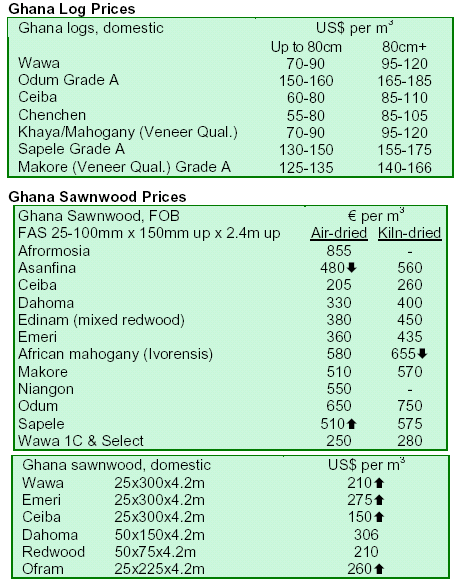
3.
MALAYSIA
HSBC to provide finance based on Equator Principles
The Business Times reported that HSBC Malaysia intends to loan money to timber companies that
can demonstrate ¡®excellent environmental and social governance¡¯ records.
HSBC has recently signed on to the Equator Principles, non-binding principles designed to serve as a benchmark
for financial institutions to ¡®assess and manage social and environmental risks¡¯ in projects. HSBC is
the only bank in Malaysia to provide financing to timber companies in Malaysia. The finance will
provide investments in forest plantations, sawmills, pulp and paper milling and wood
preservation.
HSBC¡¯s announcement came on the sidelines of the Malaysian Forest Dialogue, where participants
noted the need to draw more attention to social and environmental concerns in the timber industry.
It was noted that most consumers are still unwilling to pay a premium for certified timber and that a
¡®green premium¡¯ would help facilitate certification in timber producing countries. In
2006, the Malaysian timber industry earned RM23.4 billion in exports, accounting for 4.5 percent of
Malaysia¡¯s economy and providing jobs to about 337,000 people.
Monsoon season leads to price hike
The rainy season has begun across most of Malaysia. As a result, prices for most timber products
have begun to rise as harvesting of timber becomes difficult in wet conditions. This year¡¯s monsoon
season may strike fear of a recurrence of the devastation caused between November
2006 and January 2007, when timber prices were at record highs. Higher energy costs and the appreciation of
the Malaysian ringgit against the US dollar have also added pressure on Malaysian timber prices.
Rimbunan Hijau to set up MDF plant in Russia
Japan Lumber Reports stated that the Malaysian forest company, Rimbunan Hijau, would build an
MDF plant in Russia, a move that would help the company cope with Russian export taxes. The
new MDF plant would be its first in Russia and would eventually have continuous press
lines for MDF manufacturing. The MDF products would be exported to China, Japan, Malaysia and Indonesia
and marketed within Russia as well. The company said that it would consider building lumber and
veneer manufacturing facilities once the MDF plant was complete.
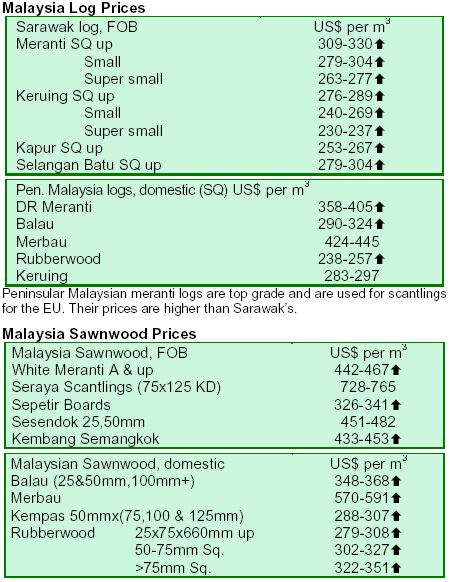
4.
INDONESIA
LEI starts certification work with Asmindo and PT Setyamitra
To facilitate the implementation of the Indonesian Ecolabelling Institute¡¯s (LEI) recent initiatives on
ecolabelling (TTM 12:18), Indonesia¡¯s furniture and handicraft group (Asmindo) and furniture maker
PT Setyamitra have signed a memorandum of understanding (MOU) to work with LEI. The Jakarta
Post reported that under the MOU, the organizations would market products from certified forests
and use improved technologies to maximize environmental benefits. Asmindo chairman said
that it was hoped that others would follow PT Setyamitra¡¯s example in ¡®preserving the environment and
rejecting the use of illegal logging¡¯.
Forestry Minister highlights importance of Bali Conference
During a recent event, Forestry Minister NS Ka¡¯ban said that the UN Framework Convention on
Climate Change upcoming Conference of the Parties, which will be held in Bali during the first week
of December, would provide an opportunity for Indonesia to show its commitment to
addressing climate change. He explained Indonesia¡¯s role in helping to reduce emissions from its existing
forests and noted that deforestation¡¯s linkage to carbon emissions would be addressed at the
conference. While he drew attention to Indonesia¡¯s previous rates of deforestation, he
said that Indonesia was turning around its environmental situation, including by undertaking a mass
reforestation initiative at the end of November (TTM 12:19).
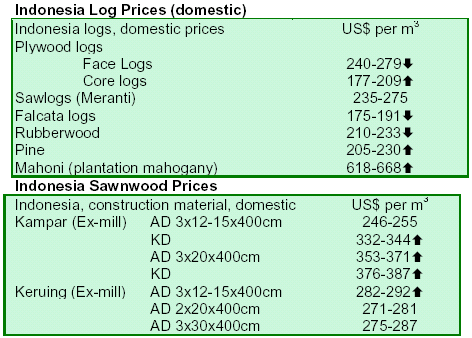
5.
MYANMAR
EU may ban Myanmar timber
TTJ Online reported that the EU might impose a ban on timber imports from Myanmar to protest
human rights abuses in the country. During an EU Council meeting on 15 October, ministers
developed measures to enact pressure on the Myanmar government, including a ban on
equipment exported to Myanmar for its logging and timber sector, an import ban on Myanmar¡¯s wood products
and an embargo on EU investments in the sector. While the ban was not adopted outright, the EU
was reviewing the introduction of these measures and stood ready to work with the government in
Myanmar should they express willingness to do so. An EU ban would mainly impact the
Myanmar teak industry, which continued to harvest and sell teak from natural forests.
Myanmar log prices slump amid EU proposed measures
During the past two weeks, prices for log grades used by Europe fell substantially. Proposed
actions taken by the EU to limit monetary transactions might have some influence on this month¡¯s
tender prices. For India and the rest of the Far East, it was business as usual, although
others speculated this might be indicative of a ¡®wait and see¡¯ attitude with regard to the political situation in
Myanmar. As Europe and the US are the final markets for high-end teak products, experts are
uncertain as to how the situation may develop in the coming months. The average
price of US$420 for export quality pyinkado is much less than the list price (US$470 to US$500). However, newly
harvested pyinkado logs at export grade are being sold at list price.
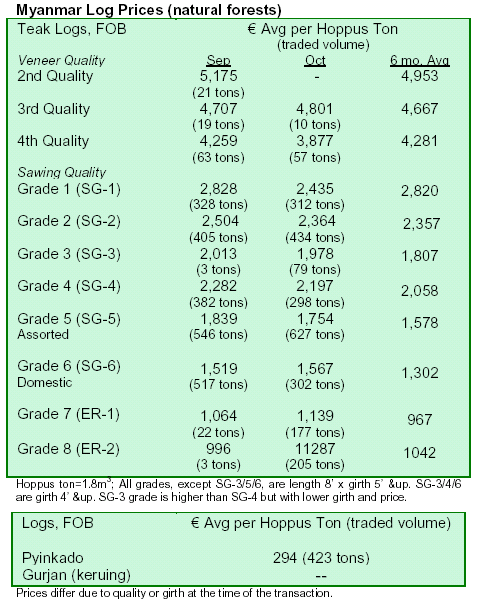
6.
BRAZIL
Government reviews plans as Amazon deforestation
accelerates in 2007
The publication O Estado de Sao Paulo said that the Brazilian government was preparing
emergency action to curb the increasing rate of deforestation in the Amazon.
The action was prompted by recent data indicating that deforestation had accelerated in 2007. Satellite systems
showed the deforestation rate in the state of Mato Grosso increased 107% between June and
September 2007, compared to the same period in 2006. Deforestation in the Amazon was the
highest in Mato Grosso, although experts said that the increasing trend was likely to be prevalent in
other states.
Actions under the Plan to Combat Deforestation using command and control activities were deemed
successful, having kept deforestation rates largely under control from 2004 until the start of 2007.
However, since rates of deforestation have jumped in 2007, the Plan to Combat
Deforestation is currently being revised. In the short-term, the plan will apply command and control measures,
especially in the states of Para Mato Grosso and Rondonia. In the medium-term, the government
expects to work with about 30 Amazonian municipalities where the deforestation rate is high. In the
long-term (2008-2010), the Ministry promises to look into mechanisms, especially
financial, to promote sustainable logging. The federal government will also demand greater participation of the
state and local authorities in designing ways to control deforestation.
Demand for elliotis pine plywood subdued by falling US dollar
EUWID reported that demand for elloitis pine plywood had remained ¡®subdued¡¯ in recent months and
that upturn in demand was not expected in the near term. The primary reluctance of buyers to
engage in new deals is due to uncertainty surrounding the US dollar and corresponding
changes in prices. Prices have and are expected to remain unchanged in the next few weeks. Shipments of
pine plywood are expected to be more positive in coming weeks, as enquiries have already started
by individual importers.
Furniture fair aims to strengthen domestic market
The 'Movel Brasil' fair, which showcases furniture, decorations and components), will gather 90
furniture producers in the Sao Bento do Sul cluster in Southern Brazil. The companies have
extensive experience in the international market and are interested in opening or
expanding their business in the domestic market. The cluster encompasses 450 companies and employs 12,700
workers. In 2006, the furniture sector of Sao Bento do Sul reached BRL878 million in revenues.
This represented 33% of the regional economic revenues.
The fair is timely due to the fall of the central bank¡¯s interest rate, expansion of the real estate
sector and consumers¡¯ preference to buy home furniture. The fair is expected to show the
recognized production capacity of local companies in meeting the needs of the Brazilian
market and international quality standards. The furniture manufactured in the region meets the requirements for
forest management and wood working. The companies of the cluster guarantee on-time delivery
of high standard services and high quality products.
Federal Bank helps boost furniture consumption
Diario de Natal said a new credit line from Caixa Economica Federal (a federal credit bank) would
be launched for the hotel segment, bars and restaurants in Northern Brazil, especially in Rio
Grande do Norte. This is likely to help renew hotel furniture and increase the
regional consumption of the products from other regions of the country. The details of the new line are being
discussed by the Brazilian Association of Hotel Industries (ABIH RN) together with the Union of Furniture
Industries (Sindimoveis RN). The credit line is directed to companies related to hotel and furniture
companies that will attend the first Potiguar Tourism Fair and the second Fair of Equipment and
Materials for the Hotel Sector (Fequimatel). Caixa Economica Federal will present the
financing details target for small, medium and large-scale companies of the sector.
Brazil¡¯s exports of wood products ease in September
Exports of wood products (except pulp and paper) decreased 2.8% in September 2007, compared
with the same period of 2006, when USD 355.3 million was exported. This year, total exports in
September reached USD345.4 million. Pine sawnwood exports decreased in value by 0.1% in
September compared to the same period in 2006. However, volume rose by 0.5% in September
2006 to September 2007.
Tropical sawnwood exports increased 14.6% in value in September 2007 from a year ago, from
USD62.4 million to USD54.4 million. The volume of exports also rose 1.6% in September 2007
compared to last year, from 139,475m3 to 141,726 m3 in September 2007.
The exported volume of pine plywood reached 139,754 m3 in September 2007, decreasing 1.2%
from 2006 levels. However, pine plywood rose in value 35.2%, from USD34.2 million in September
206 to USD46.2 million in September 2007. Tropical plywood exports decreased in
volume from 41,830 m3 to 29,926 m3 in September 2007, indicating a fall of 28.5%. In value, it fell 17.6% from
USD20.3 million in September 2006 to USD16.8million in September 2007. During the same period,
exports of wood furniture also fell slightly by 4% in value.
US Housing crisis impacts wood sector in Southern Brazil
Gazeta do Povo carried a story explaining the impact of the US housing crisis on the wood sector
in Southern Brazil, mostly in the state of Paran¨¢. US housing starts have reached their lowest level
in the last ten years. This, together with the depreciation of the US dollar in Brazil,
has affected sales of pine plywood, doors and wood frames used in construction. Pine plywood exports to the
US, the main importing market, fell to less than half of the previous year¡¯s levels. Pine plywood
exports to the US dropped from 640,000 m3 from January to September 2006 to 283,000 m3 in the
same period during 2007, according to the Brazilian Association of Mechanically-Processed Timber
Industries (ABIMCI).
The significant decrease in solid wood product exports for the North American construction sector
had resulted in closures of local factories and dismissals of workers in Brazil. Two North American
multinational companies announced the closure of their production lines for mouldings and frames.
One company had dismissed 400 employees. Another company reduced its moulding
production by 30%, almost all of which was exported to the US, and also laid off 250 workers, equivalent to
10% of its total personnel.
Brazil continues to be concerned about the effects of the US housing crisis and the construction
sector in North America. Due to the reduced demand for pine plywood, US prices, traditionally
higher than European pine plywood prices, are already 10% lower than in Europe.
While Europeans are paying USD290 per m3 for pine plywood, the US customers pay USD260 per m3. On the
other hand, the housing crisis may also push Brazil to seek new markets outside the US. One large
Brazilian exporter in the wood products sector has already begun to export to
Europe, Australia, South Africa and Turkey, among other countries.
Federal police operation cripples illegal exporters
The Agencia Brasil and Diario de Cuiaba reported on operation ¡®Wood Stock¡¯, a federal police
operation which aimed at dismantling criminal organizations involved with illegal logging and illegal
export of precious woods, especially ¡®jacaranda-da-bahia¡¯. Such timber had been
illegally logged in the south of the Bahia state and had been transported to the neighboring states of Espirito
Santo and Minas Gerais, where the wood was illegally exported. Over the last four years, at least 13 tons
of wood products were illegally produced and exported.
According to federal police, the criminals had harvested the logs without proper legal permits, using
false documentation and receipts to transport logs. Furthermore, they concealed part of the timber
load, with the reported value below the expected market price. According to the
Brazilian environmental protection agency IBAMA, ¡®jacaranda-da-bahia¡¯ is a species on the brink of
extinction. Recent actions of the federal police have had the support of the US Fish and Wildlife
Service, which has been monitoring wood exported to the U.S.
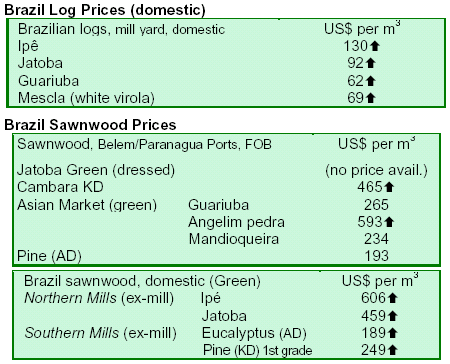
7.
PERU
Loreto leads in wood product exports
According to the Association of Loreto Lumber Entrepreneurs (AIMAL), forest activities in the Loreto
region contribute significantly to the regional and national economy. An AIMAL spokesperson
stated that 78 sawmills, three plywood mills and around 130 dry kilns currently exist in Loreto. The
Association estimates that 65,000 jobs have helped raise the socio-economic wellbeing
of the local population. Loreto sets 80% of its wood products for export with 20% for local consumption.
Wood products are exported by approximately 50 companies in the Loreto region.
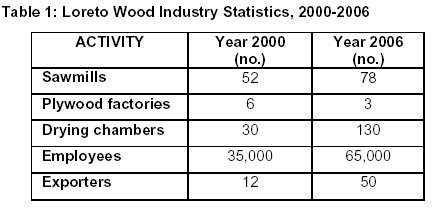
AIMAL said wood products exports have been growing since 1996. The value of 2006 wood products
exports increased nine-fold from 1996 levels, reaching USD27.5 million in 2006. The main
destination countries of exports are Mexico, the US and Canada. Mexico is the most
important consumer of Loreto¡¯s wood products, accounting for an average of 72% of Loreto¡¯s total
exported volume. The US imports 20% and Canada 4%. The remaining 6% goes to China, Hong Kong and
Dominican Republic. Loreto¡¯s steadily growing exports contributed 23.5% of the total wood products
exports nationwide in 2006.
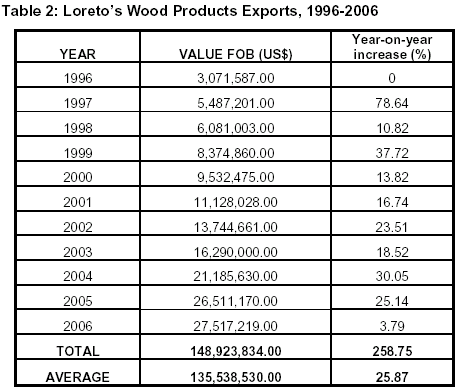
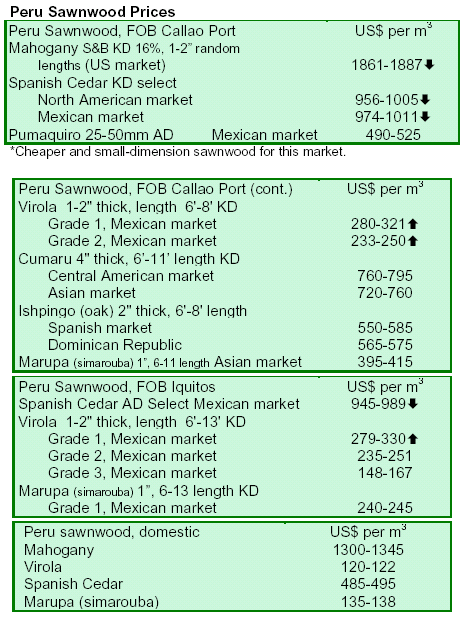
8.
MEXICO
Tamaulipas invests in commercial forest plantations
By the end of 2007, the state of Tamaulipas will have produced nursery stock of three million
seedlings for commercial plantation forests. The main species to be planted are eucalyptus, teak,
gmelina, red cedar, mesquite and ebony. To obtain the seedlings, the State of
Tamaulipas, through the Secretariat of Rural Development, has invested 15 million pesos provided by
the Union of Foresters and Forest Industrialists of Tamaulipas AC. The Regional Association of Forest
Planters and Foresters of San Fernando AC has helped install infrastructure to breed the seedlings and has
the capacity to produce four million plants per year.
Tamaulipas has the potential to establish 158 thousand hectares of commercial forest plantations,
which by the year 2025 could produce a total of 3.7 million m3 of wood, in contrast to the 117
thousand m3 produced at present. When the nurseries breeding grounds at Tamaulipas start
operating, they will have the capacity to produce tree stock of four million plants per annum. The
breeding ground in San Fernando will be the biggest in Tamaulipas with a capacity to produce two
million eucalyptus plants alone.
In addition, the state government has strengthened the Trust for Forest Development in Tamaulipas
(FIDEFOSET) that provides economic support to individuals who establish plantations. Efforts to
advance the establishment and maintenance of commercial forest plantations in Tamaulipas will
contribute to the country¡¯s goal of establishing 100 thousand hectares of plantations
in the country.
9.
PANAMA
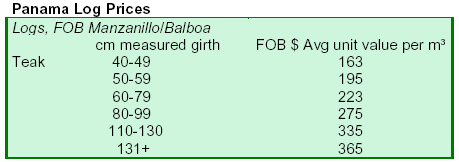
10.
BOLIVIA

11.
GUYANA
Government will not back down on Barama sanctions
Guyana Online reported that the government was standing by its recently imposed sanctions on
Barama Company Limited. The government recently slapped Barama with a USD96.4 million fine
and told it to suspend contractual operations with three local firms. These actions were taken
after the Guyana Forestry Commission conducted an investigation of Barama¡¯s operations and
concluded they had breached procedures in sub-contractual operations. In spite of protests by
Barama employees, Forestry Minister Robert Persaud said he would find resolution of the issue
through constructive engagement with Barama and efforts would be made to protect workers from
suffering due to the company¡¯s behavior.
Guyana forest administration questioned
The CFA Newletter recently contained an article in which experts questioned forestry administration
in Guyana. The article suggests that Guyana has allowed Asian logging companies to ¡®run down
the mills¡¯ and offer lower forest and log fees. It alleges that Guyana fails to ¡®price
appropriately the access to its forest resource, fails to collect debts on that access and fails to use appropriately
the taxes that are collected¡¯. The article strongly suggests that weaknesses in governance and
corruption are to blame for these failures in Guyana¡¯s forestry activities.


|